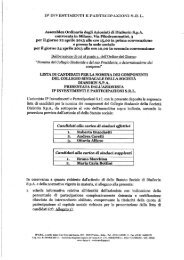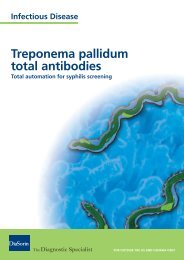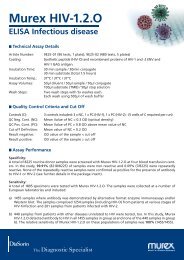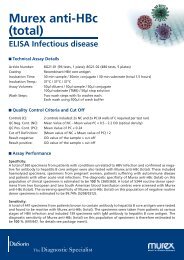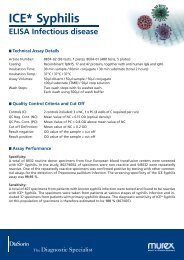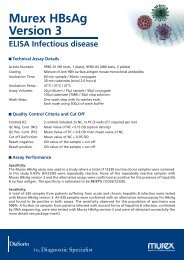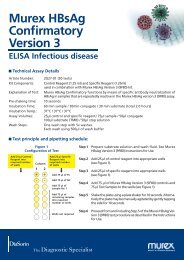Syphilis Booklet - DiaSorin
Syphilis Booklet - DiaSorin
Syphilis Booklet - DiaSorin
You also want an ePaper? Increase the reach of your titles
YUMPU automatically turns print PDFs into web optimized ePapers that Google loves.
simultaneously and produce clinical conditions<br />
similar to some other diseases. Its primary mode<br />
of infection is by direct contact with a productive<br />
lesion or transplacental transmission.<br />
1.2.1. Pathogenesis<br />
Treponema penetrates microscopic skin lesions<br />
but can also cross intact barriers. Incubation<br />
Table 2: Nomenclature and some properties of treponemal polypeptides most<br />
often used in serological diagnosis<br />
Flagellar Polypeptides<br />
Identification<br />
TpN 15<br />
TpN 17<br />
TpN 24,27,28<br />
TpN 29<br />
TpN 30<br />
TpN 33<br />
TpN 34<br />
TpN 35<br />
TpN 37a<br />
TpN 39<br />
TpN 44<br />
TpN 47<br />
TpN 60<br />
Other names and functions<br />
Flagellin B3<br />
Flagellin B2<br />
Flagellin B1<br />
Flagellin A<br />
Basic membrane protein<br />
Surface antigen<br />
Common antigen<br />
Reactivity in syphilis<br />
67%<br />
89%<br />
*<br />
*<br />
35%<br />
92%<br />
External membrane proteins<br />
Tromp 1<br />
Tromp 2<br />
Tromp 3<br />
31 kDa (TroA)<br />
28 kDa<br />
65 kDa<br />
Polypeptides shared with flagella<br />
Tpm A 45 kDa PCR target<br />
Antioxidant proteins<br />
TpO 823<br />
TpO 509<br />
Superoxide to peroxide<br />
Hydroperoxide reductase<br />
* Normal sera can contain low titre antibodies<br />
Table 3: Tpr membrane protein genes<br />
Family Tpr A Tpr B Tpr C Tpr D Tpr E Tpr F Tpr G Tpr H Tpr I Tpr J Tpr K Tpr L<br />
Subfamily* III III I I II I II III I II III III<br />
* Based on DNA homology<br />
5



